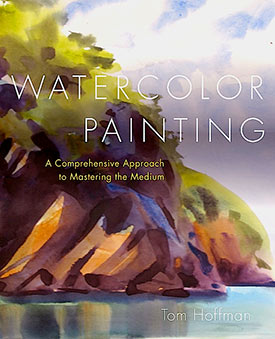©2012 Watson Guptill, 2009 | Watson-Guptill
Format: Hardcover, 208 pages
ISBN: 978-0-8230-0673-1
Price: $35
The watercolor shelf in the bookstore is full of “how to do it” books that concentrate on techniques for getting the paint to do what you expect. After 40 years of concentrating on watercolor, I am convinced that technique is the easy part. The real work lies in knowing when to do what. Think of this book as a “how to know what to do” guide to watercolor.
Learning to see your subject in watercolor terms requires translating reality into a progression of washes and strokes. As your interpretation of the subject develops, you make decisions regarding Value, Wetness, Composition and Color. Because of the transparency of watercolor, a finished painting can be seen as a record of those decisions. Everything shows, which is both the promise and the challenge of the medium. It makes sense, then, to make those decisions deliberately.
Before I head out the door to paint, I want to make sure I’ve got all the materials I need: paper, brushes, water, paint, hat, board, tape. Check! Going down that list is similar to what has to happen before the brush touches the paper. For each watercolor variable, there are questions that need to be answered. The shadow on the tree trunk will come out right enough for me if I have remembered to ask what color it is, how dark, what kind of edge it has, and where I want to put it. Color, Value, Wetness and Composition. Check!
If I don’t know the answers to a few essential questions, my brushstrokes will be tentative at best, and the clarity and fluency of the paint will suffer. To me, nothing is more important than the beauty of the paint itself. Developing a thoughtful approach to painting leads to confident paint application, which is the essence of fearless watercolor.
